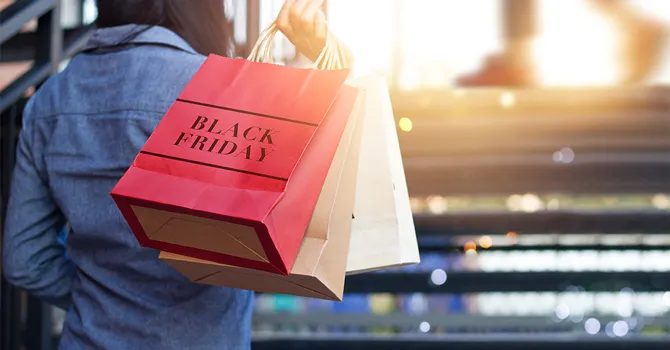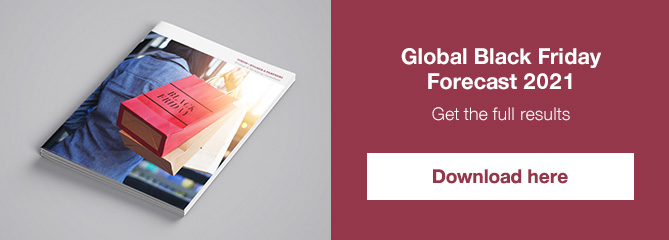In contrast to last year’s reduced interest in Black Friday, more and more consumers are planning to take advantage of this year’s holiday shopping season’s offerings. However, as our latest survey reveals, some changes in purchasing behaviors are here to stay. Find out what this means for companies across different regions and industries:
Two of the most exciting days for avid shoppers are coming soon: On the 26th and 29th of November, Black Friday and Cyber Monday deals will go live all over the world. Time for our longstanding Black Friday Forecast, focused on changes in purchasing behavior and demand. Last year, our survey reflected the effects of the COVID-19 crisis: lower planned budgets and a significant shift towards online shopping (due to safety reasons). What do the results reveal this year?
Black Friday remains extremely popular
In October 2021, we surveyed more than 11,000 people across 17 countries (Belgium, Brazil, China, Columbia, Denmark, Germany, Italy, Mexico, Netherlands, Norway, Saudi Arabia, Spain, Sweden, Turkey, UAE, UK, USA) about their shopping preferences and plans for this year’s holiday season. One of the key insights: Black Friday and Cyber Monday (Singles Day in China) continue to grow in popularity across the world. In 10 of the 17 countries, 100 percent of participants had heard of Black Friday. And in the remaining countries, Black Friday awareness ranged from 97 to 99 percent. Whilst last year’s numbers were already high (between 84 and 100 percent), awareness still managed to increase. The recognition rates for Cyber Monday are – as expected – a little lower: 68 percent on average have heard about it.
Commercial potential on the rise: More willingness to buy and higher budgets
Manufacturers and retailers won’t only benefit from increased awareness when it comes to these shopping days: Our study participants also indicated an increased willingness to buy and higher budgets for Black Friday/Cyber Monday shopping. Across almost all countries, the majority of respondents indicated their intention to buy something on these days. In addition, the average amount consumers plan to spend has risen compared to last year. This year, the average budget is 236 Euros. However, there is a significant difference among countries: Consumers in China (399 Euros), the United Arab Emirates (330 Euros), and Saudi Arabia (280 Euros) plan to spend the most. Respondents in Colombia (152 Euros) and Brazil (161 Euros) indicated the lowest budgets.
Changed shopping behavior: Consumers still shopping more online and locally
In last year’s Black Friday Forecast, many consumers stated a heavy influence of the COVID-19 crisis on their shopping behavior. This year, many of these changes are sticking around. Across all countries, over 60 percent of respondents agreed that the pandemic impacted their purchasing habits. And most respondents stated that they will maintain these behavioral changes. For instance, 75 percent of consumers intend to increase their amount of local shopping and 69 percent will maintain their lower spending budgets. And online shopping is still on the rise: This year, 45 percent of consumers on average prefer shopping online, compared to 41 percent last year.
Close up: Differentiated views of study results
Now, let's go into a little more detail: We asked our experts from different regions and industries to share their view on our study results:
Black Friday seems to have rebounded this year, with awareness at almost 100 percent in all markets and enthusiasm back at pre-pandemic levels. Does this match what you’re seeing in your region?
Shikha Jain, Partner, US: Absolutely. There is no surprise that there is high awareness of Black Friday in the US. First, it is closely tied to the US Thanksgiving national holiday and in fact, Black Friday is scheduled specifically for the day after Thanksgiving year over year. Second, there is wide media and retailer coverage of the holiday. It is an expectation for almost all retailers to offer deep deals for the holiday, and many people have school or work off as part of a 4-day “Thanksgiving weekend” and spend part of the time shopping for these deals. Third, culturally the day is usually the official kick-off to the Christmas/Holiday season which reminds people to start thinking about their holiday shopping. Paired with a 4-day weekend, many people would have naturally drifted to spending the day doing some shopping anyways, and that is exponentially heightened by the media coverage and deep discounts offered.
Retailers take full advantage of this awareness: They post teasers of their deepest discounts and have count downs on their websites; they stretch out the holiday with Pre-Black Friday or Early Access Black Friday deals; and brick and mortar locations often have special, extended operating hours to accommodate the shopping demand.
Hakon Saeberg, Senior Director, Norway: Nordic consumers were less affected by the pandemic to begin with, with more than 40 percent saying their shopping behavior was unchanged, compared with a global average of 26 percent. We also see this in their channel preferences, where offline shopping remains strong. In fact, in Norway there are more consumers who say they will shop offline than online. Nordic consumers also say they will spend less. Denmark and Sweden are the only European countries where we see a decline in the average reported budget for Black Friday, going down 14 percent and 17 percent respectively. This could point to a smaller rebound effect in the Nordics than in other regions.
What would you say are the key drivers for consumers to participate in Black Friday this year, and what are they typically looking for?
James Brown, Managing Partner, UK: It has simply become a habit. It’s only taken a few years – certainly in the UK – for Black Friday to displace the role of the January sale for many consumers, and for retailers to train their customers to expect a deal at this time of the year. It expanded from a day to a week and even to a full month of discounts. Consumers wait to buy, knowing they can get some genuine deals, but also that prices outside this period are likely inflated a bit. And that’s a challenge from retailers who have a real FOMO (fear of missing out) themselves!
The satisfaction of getting a bargain and the justification of some indulgent purchases for oneself can’t be overlooked as Black Friday drivers as well. There will also be other consumers looking to buy now before prices go up, with inflation rocketing and supply chain constraints making must have Christmas list items far riskier to wait until later.
What they are looking for is simple: a discount, something beyond what they’d usually get, though it isn’t essential, a seamless shopping experience, and prompt delivery!
Miguel Angel Herrero, Director, Spain: In Spain, we see that due to the lockdown and the different government restrictions, people had limited ability to spend money and have been able to save more. This, linked to the desire to kick off some Christmas shopping, will incentive participation in Black Friday.
The categories that seem to be more appealing for consumers compared to previous years are all related to home improvement. Spending more time at home has caused people to want to invest here: Furniture, electronic equipment, appliances, and decorations are all looking popular.
In your region/industry, are there any best practices from companies for Back Friday/Cyber Monday you would like to share?
Shikha Jain, Partner, US: There are three industry best practices we see for Black Friday that turns Black Friday from a straightforward promotion to an event that furthers a company’s medium- and short-term goals.
First, retailers are very intentional about where and when they place their deepest discounts. They often select a few high demand items to act as traffic drivers and anchors for the event and discount them deeply enough to be picked up the media as a strong Black Friday deal. This in turns drives overall awareness and consideration for the brand that may last beyond the holiday. In a brick-and-mortar location this is paired with placing these traffic driving items at the back of the store to maximize the opportunity for consumers to build their basket on their way to the prize.
Second, retailers have made early access to deals valuable by applying limited supplies for the deepest discounts, but that valuable first access may be only available if consumers sign up for a membership program or opt in to receiving emails. This develops a customer base for marketing efforts even after the holiday.
Finally, the best retailers utilize Black Friday to drive repeat business by having multiple, selected “deal drops” throughout November. This incentivizes customers to come back to the website or retailer over and over to see new deals, with discounts generally getting deeper until the best ones are available for Black Friday itself.
As we mentioned above, Middle Eastern countries have reported the highest budgets for Black Friday. Why do you think that is?
Lovrenc Kessler, Managing Partner, UAE: Although it is no secret that Middle Eastern consumers indeed have higher shopping budgets (e.g., female Emirati citizens spend 43 percent of their income on fashion shopping alone), there are other factors too that contribute to their relatively higher intended spend amounts during this Black Friday. The United Arab Emirates and Saudi Arabia are among the top 15 on the global purchasing power index, owing to factors such as high salaries and low tax environments. This means that the consumers simply have higher purchasing power, given their salary to expense ratio.
Consumers in both countries also have relatively sophisticated tastes and a higher preference for luxury shopping, leading to a natural increase in the value of their shopping basket. This year, Middle Eastern consumers (with income above 5,400 US dollars) plan to spend a whopping 30 percent of their income on luxury items.
Lastly, given Black Friday's high awareness in the region (around 98 percent), Middle Eastern consumers are smart in the sense that they often hold back their purchases, waiting for the holiday season to leverage attractive deals, further increasing their shopping value.
With Black Friday and Cyber Monday as popular as they are: What’s your advice on how retailers should prepare?
Nina Scharwenka, Global Head of Consumer, Germany: Our advice is: Have a clear picture of who your shoppers are as well as a targeted strategy. Yes, all shoppers expect to see discounts, but in many countries the expected level has not risen. This indicates that Black Friday means more to shoppers than just savings. In Germany for example, we observed two very interesting groups that look for more than just the usual discount: Convenience-seekers who like to shop online and can be won over with an optimal user experience. And Experience-seekers who crave for live events. Those could be convinced by creating a special atmosphere and happenings in-store.
With regard to pursuing other discount events such as Singles’ Day, we recommend to be careful and not treat Singles’ Day the exact way as Black Friday. As Singles’ Day is known primarily among GenZ shoppers, this should be the retailer’s primary target group for equal leverage compared to Black Friday and a choice has to be made: Either offer your key discounts on Singles’ Day or on Black Friday. Otherwise, there is a risk of starting the pre-holiday discount season even earlier.

